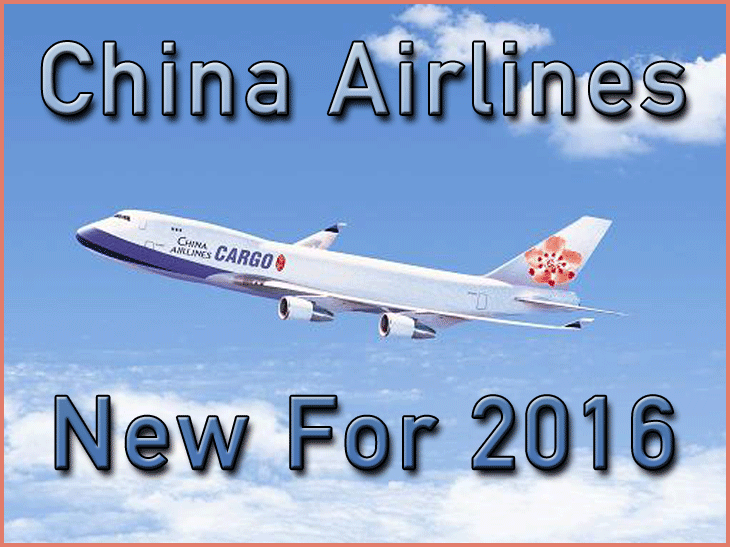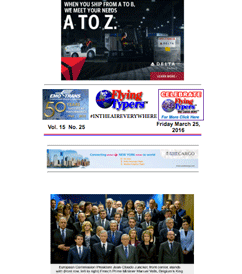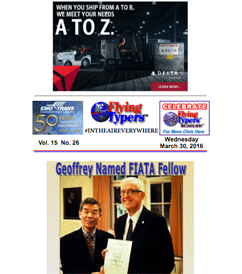
Taiwan-headquartered
China Airlines is hoping free trade agreements under
negotiation or already in place and high demand for
niche cargoes and sports equipment will boost cargo
demand as 2016 unfolds.
CAL will introduce two B777s
and four A350s this year; the B777 will fly the SFO,
LAX, and JFK routes while the A350 will fly European
and Australia/New Zealand routes. The capacity additions
will mean overall cargo capacity is expected to grow
by 2-3 percent during the year, but according to Jeremy
Chang, Vice President of Cargo Sales & Marketing
Department, there is room for some optimism this year,
despite the barrage of bearish economic forecasts and
indicators released recently.

“The 12 member nations
of the Trans-Pacific Partnership (TPP) reached an agreement
on October 5, 2015, to remove more than 10,000 import/export
tariffs and other non-tariff obstacles,” he said.
“This is expected to help increase Japanese exports
of automobiles and automotive parts as well as boost
the imports of textiles and exports of clothing from
Vietnam.”
Chang told FlyingTypers that the looming Rio Olympics would also boost exports
of specialty clothing and sporting footwear from Southeast
Asia and he was optimistic about demand for uplift of
semiconductors, not least into Taiwan. “Semiconductor
Equipment and Materials International (SEMI) forecasts
indicated that capital expenditure by the global semiconductor
industry would continue to grow in 2016,” he said.
“As Taiwan has the world’s highest capital
expenditure, CAL is therefore bullish on demand for
shipping of imported machinery and equipment from the
U.S, Japan, and Europe to Taiwan.”
However, Chang said the parlous
state of the global economy as well as the slowdown
of Asia’s manufacturing sector meant that export
growth from Taiwan was expected to flatten out during
2016. “International institutions—the World
Bank, OECD and IMF—have all lowered their forecasted
global economic growth rates for next year,” he
explained. “OECD also indicated that global trade
growth has now dropped to global economic recession
levels. Fortunately, the increasing global popularity
of sports and recreation, as well as growing demand
for electric vehicles, mean that Taiwan’s functional
textiles and electric vehicle components will become
key drivers of air cargo exports.”
CAL also expects to benefit
from its sea-air agreement with leading container line
Yang Ming Marine. CAL signed an MOU with Yang Ming Marine
in mid-November to form a “Sea-Air Grand Alliance.”
The two companies then further expanded the strategic
partnership to include Chunghwa Post last December in
an effort to profit from the growing web commerce market
by offering a new door-to-door delivery service.
“With the addition of
Chunghwa Post, we aim to expand into the segment where
bulk container shipments of goods ordered on major online
shopping platforms are stored and processed for door-to-door
parcel delivery,” said Chang. “Moreover,
we plan to establish a joint online shopping platform
that is scheduled to be introduced in April next year.”
The Yang Ming collaboration
consists of three services: “Cargo-to-Post,”
“Joint Sea-Air Freight” and “Joint
Air-Sea Freight.” Customers using “Cargo-to-Post”
are able to ship ocean cargo from China to Taiwan where
postal mail tags are attached before the cargo is exported
via air cargo to the U.S. The “Joint Sea-Air Freight”
product sees cargo from SE Asia and China transported
by sea to Taiwan and Dubai before being sent by air
to the U.S. and Europe. The “Joint Air-Sea Freight”
service will see European/American cargo shipped by
air to Taiwan and then transshipped to SE Asia by sea.
“The conversion of Chinese
cargo to postal service does not incur additional tariffs
because the cargo to be transshipped by sea will enter
the dedicated transshipment warehouse at Taoyuan International
Airport,” explained Chang. “The mailbag
tags will be added under the supervision of Customs
or dedicated personnel. The converted mailbags are then
exported directly by air. The joint sea-air/air-sea
cargo is transported by bonded trucks to the bonded
zone for transshipment so there are no additional tariffs
either.
“The joint freight services
not only offer customers additional shipping options—for
example, the cost of shipping is lower than air cargo
and shipping time is shorter than sea cargo—but
are also a response to the growth in the export of Chinese
cargo arriving for transshipment by air before being
exported as mail bags. This will help with the delivery
of foreign cargo around the world through the postal
system after they arrive in Taiwan for transshipment.”
Chang said the overall growth
in demand for air cargo had been limited in the second
half of 2015 due to continued weakness in the Asian
manufacturing sector and lower-than-expected throughput
from air cargo-related industries.
Although full year volumes handled
by CAL had not been released when FlyingTypers interviewed Chang, he said expectations were that volumes
growth had been positive. “Growth in international
Freight Revenue Ton-Kilometer (FTRK) is expected to
reach 2-3 percent due to CAL’s continued optimization
of our capacity allocation and development of potential
market sources (e.g. changing the European transshipment
hub to Dubai [DWC], the addition of Shenzhen [SZX] as
a freighter destination, and additional freighter flights
to Tokyo, Hanoi, and Ho Chi Minh City).
“We have also strengthened
our collaboration with international couriers, SkyTeam
Cargo, and sea freight operators to develop new courier
sources and joint sea-air freight business opportunities,”
he said.
Chang said one of the bright
spots last year was the performance of the Transpac
lane, which was “outstanding,” not least
because of the cargo backlog at U.S. West Coast ports
between late 2014 and 2015 Q1 driving up demand for
charter flights between Asia and the U.S. and also pushing
up U.S. shipping prices.
“Due to cargo owners shifting
from sea to air cargo, CAL dispatched three charter
flights carrying 3C cargo from Taipei to Seattle and
one charter flight carrying French fries from Los Angeles
to Tokyo. In 2015 Q1, CAL also dispatched 17 charter
flights from Taiwan/Japan/Vietnam to the U.S.”
The resolution of the West Coast
port backlog saw the cargo market return to normal levels
after Q2, though CAL’s Transpac cargo revenue
grew moderately between September and November. “While
the Thanksgiving holidays in the U.S. meant a reduction
in Transpac cargo volume in the last week of November
and the onset of the cargo off-peak season in December,
CAL strengthened our collaboration with international
integrators on courier sources to improve unit revenue
and loading,” he said. “This helped to alleviate
the impact from slackening market demand.”
On European lanes, overall cargo
demand remained flat last year due to the slow recovery
of the economy and manufacturing sector. “Measures
such as the switching of transshipment hub to DWC, reducing
of freighter capacity as necessary, and operating 777s
with large holds for FRA, however, should see the European
lane outperform last year’s results,” he
added.
Sky King
|





